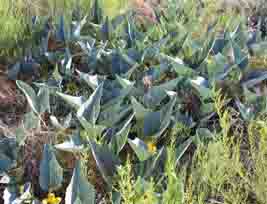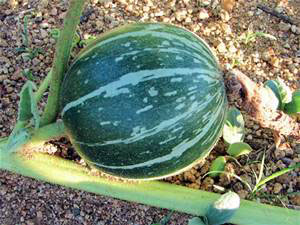 |
 |
Food:
"Buffalo gourd seeds have been recovered from Anasazi and even more ancient archeological sites. Both the seeds and the blossoms probably were eaten in early days but definitely not the other plant parts, for they contain cucurbitacins, foul-smelling chemicals and perhaps the bitterest natural substances known to mankind." (Dunmire and Tierney 215)
Medicine:
"Not too many years ago Isleta Puebloans boiled the roots to extract a liquid used in treating chest pains, and the roots ground fine and mixed with water served as a laxative for Tewa people. At Zuni the seeds and flowers have been mixed with saliva to reduce swelling." (Dunmire and Tierney 216)
"According too an article in the 1929 edition of Folk-say, on 'Animal Fats in Folk Medicine': The warm flesh of the freshly-killed snake that bit you would draw out the poison from the wound. The root of the prairie buffalo gourd, beaten up and put into sweet milk, was an antidote to snake bite. This milk was taken internally and used to bathe the wound also." (Curtin 2)
"Some portions of calabazilla make a very strong purge; in fact, an overdose can be fatal. The gourd may be cleaned out, filled with water and drunk from after a short time. The resultant liquid is very bitter but most effective. The Tewa Indians grind the roots, stir them in cold water, and drink the mixture as a laxative." (Curtin 31)
"Two remedies for rheumatism are made from this plant. One is to bake the fruit in an oven, split it open, and rub it, while still hot, on the afflicted parts. And the other is to mix the ground roots with olive oil, aceite de comer, and apply. If a horse suffers from saddle sores, a decoction of the roots is supposed to give relief, and a small quantity in a bottle of water is a good catharic." (Curtin 32)
Other Uses:
"One early account suggests that the ripe gourds were used as rattles in Pueblo dances, but a craftswoman at Tesque Pueblo disagreed, saying the skin is too thin and the gourd doesn't dry properly." (Dunmire and Tierney 215)
"Pueblo Indians along the Rio Grande seem to have related accounts of using buffalo gourd insect repellent. A Cochiti elder told us he used to crush the gourd in water and sprinkle the liquid on squash plants in his garden to repel squash bugs. At Sandia tribal elder Felipe Lauriano recalls that in his youth the gourd and leaves were cut and placed in all four corners of pueblo homes to keep out insects. The ground roots once were used in sleeping quarters at Santo Domingo to get rid of bedbugs" (Dunmire and Tierney 215-6)
"The gourds also contain saponin, and agent that produces soapy lather. Thus, they have been used for cleaning purposes over the years by many American Indians and other rural desert-dwelling people throughout the Southwest. At Sandia Pueblo gourd chunks were once rubbed on clothes as a kind of soap, and at Cochiti the spheres were cut in half for scrubbing pots and dishes." (Dunmire and Tierney 216)
"Many New Mexican housewives rub the cut surface of a gourd over a grease spot to remove it from wooden floors." (Curtin 32)
"A Santo Domingo Indian told me that he was never troubled with bedbugs, as the ground roots mixed with water and sprinkled all over the room banished them immediately." (Curtin 32)
"The early New Mexican women used the gourds as darning balls. And their children play a well-known game with the wild squash seeds. One holds a few of them in his closed fist and another tries to guess their number. The command, Adivina, buen adivinador! 'Guess, good guesser!' often varied by the question Pares o nones? 'Odd or even?'" (Curtin 33)